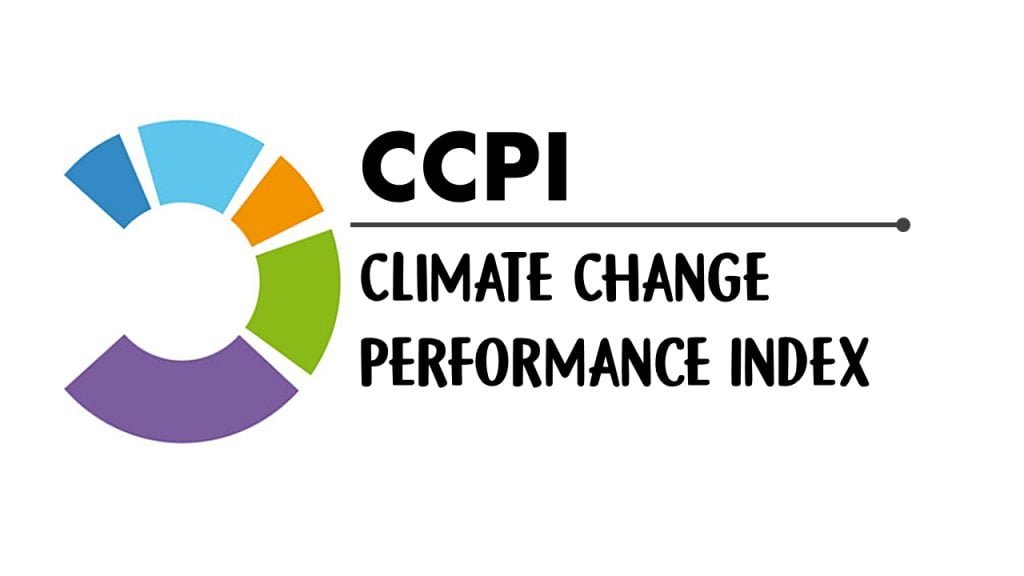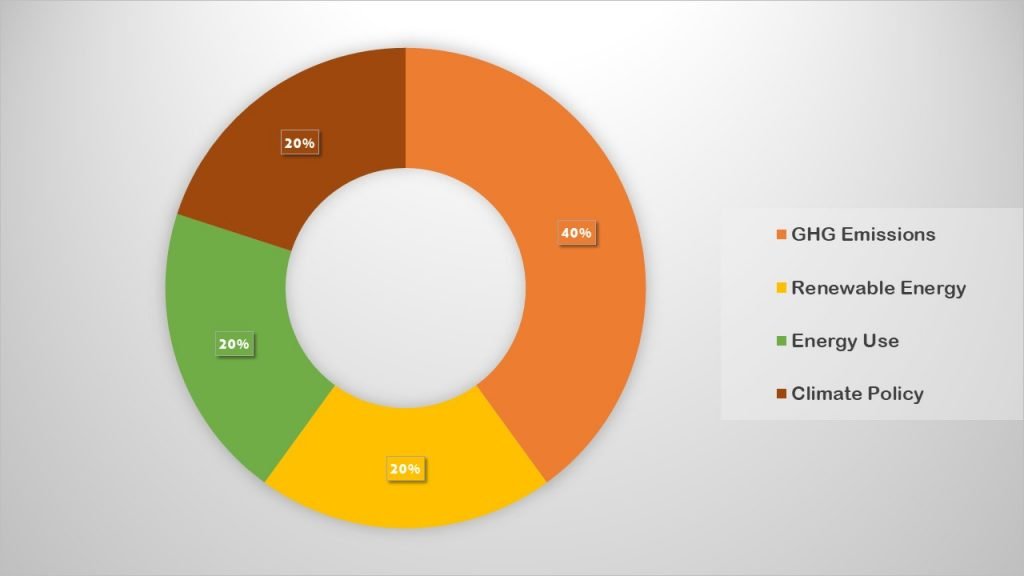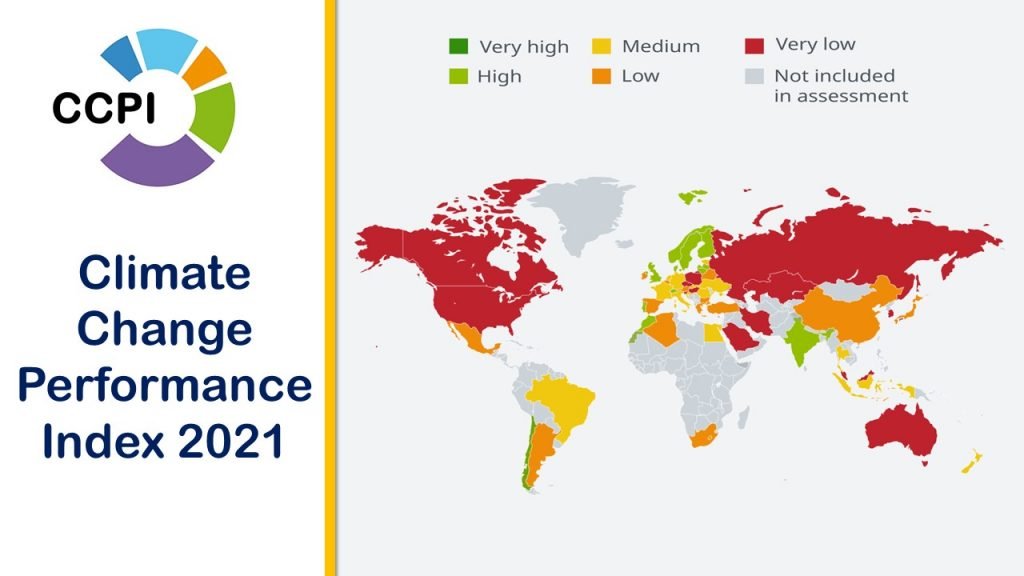Ever since the year 2005, the CCPI has done its job of providing analysis of different countries’ climate protection performance. The CCPI brings openness to climate policy by allowing us to statically compare the efforts made in climate protection, allowing us to identify both progress and failures

◉ The CCPI evaluates 60 countries and the European Union, which together generate 90%+ of global greenhouse gas emissions.
◉ To achieve the Paris Agreement goals, the CCPI evaluates the progress of countries in the implementation of policies through its unique climate policy section.
◉ In Paris, all governments sincerely pledged to bring more ambitious 2030 promises to COP26 to close the enormous 2030 emissions gap that was already visible in 2015
●⫸ What is Climate Change Performance Index?
◉ The Climate Change Performance Index (CCPI) was created by Germanwatch e.V., a non-profit environmental and development organization. It is a rating system that is used to improve transparency in climate politics around the world.
◉ The first publication of the Performance Index was released in the year 2005 and the UN Climate Change Conference is the venue for the annual presentation of an updated version of it.
The Paris Agreement’s implementation phase enters a critical phase towards the end of 2020 when countries must submit updated Nationally Determined Contributions (NDCs). The most relevant results are published in the languages of German, English, French, and Spanish.
The New Climate Institute and Climate Action Network International co-operate Germanwatch in publishing the index along with Barthel Foundation’s financial support.
◆◆ What was the Paris Agreement?
For the first time, climate action was integrated into the context of international law, under the Paris Agreement.
◉ The countries are required to make their way of distinct contributions to prevent the climate from changing hazardously.
◉ The next critical step after this agreement is for the signing countries to quickly put tangible measures in place to make their respective contributions to the global goal.
◉ For the past 13 years, the Climate Change Performance Index (CCPI) has been tracking the country’s progress in fighting climate change.
◉ Because the many countries’ initial attitudes, interests, and plans make it difficult to differentiate their strengths and shortcomings, the CCPI has been an important instrument in helping to clarify national and international climate policy
The methodology of the CCPI was again revised in 2017 to associate the results of the declarations of the Paris Agreement completely. The measures of CCPI since 2017 have been partly taking actions on the agreement made by the countries themselves created in their Nationally Determined Contributions (NDCs).
◉ The index now examines the 2030 targets and the well-below-2°C compatibility of countries’ current levels and targets in the categories of GHG Emissions, Renewable Energies, and Energy Use. All greenhouse gas emissions are likewise covered by the new methodological design. This means the modes for comparison of versions are very few.
●⫸ Why is CCPI important?
The study of climate change helps us in predicting the amount of rain that the next winter could bring, or the quantity of the rise of sea levels due to warmer temperatures of the sea. Not only that but we can also know what would be the region’s most likely to be affected by extreme weather or the names of the species of wildlife that are threatened by climate change.
◉ The goal of the CCPI is to provide insight into the process of increasing climate ambition. The CCPI can be used as a secret and powerful tool to hold against the government in times of need or for taking their responsibility to take action on the climate crisis and of making a race of people for stopping the climate action.
◉ The CCPI can be used as a reliable and long-standing tool for identifying leaders and laggards in climate protection.
◉ Only the continuing support and contributions of about 350-400 climate and energy specialists make the CCPI’s unique climate policy section feasible, which evaluates nations’ national and international climate policy performance.
●⫸ Why is CCPI important?
In the year 2017, the pre-given methodology of the CCPI was revised and was adapted to the framework of the new climatic policy under the Paris Agreement,2015.
An extension to the primary CCPI was only added to incorporate the measurement of a country’s progress on the 2030 targets as well as towards the Nationally Determined Contributions (NDCs) The performances of a nation are made accessible based on 14 indicators in the given 4 categories:
▶ GHG emissions (weighting 40%)
▶ Renewable energy (weighting 20%)
▶ Energy use (weighting 20%)
▶ Climate policy (weighting 20%)

Four equally weighted metrics define the three categories “GHG emissions,” “renewable energy,” and “energy use”:
1) Current Level
2) Recent developments (5-year trend)
3) The most recent performance based on 2°C compatibility
4) 2°C compatibility of 2030 target
These 12 measures are supplemented by two additional indicators that assess the country’s performance in terms of its national climate policy framework and implementation, as well as international climate diplomacy called “climate policy.”
◉ A detailed research study evaluates the data for the “climate policy” area every year.
◉ It is derived from a review given by the experts on climate change by some non-governmental organizations, institutions, universities, and evaluation of think tanks in the countries.
◉ Respondents rate their governments’ most important measures in a questionnaire. The outcomes are categorized as extremely high and extremely low.
◆◆ What are the results derived from CCPI?
In the 2022 index, Denmark was followed by Sweden and Norway according to the ranking. While last three ranks were taken by Kazakhstan, Saudi Arabia, and Iran.
As per the CCPI, none of the countries in the world has yet performed a perfect performance through all the indicators that can be qualified under the category of very high.
◉ It is because none of the countries could fulfill the needs of limiting global warming as agreed in the Paris Agreement, which is below 2°C. This is the reason why the first 3 places in the final draft of the ranking remain unoccupied
●⫸ CCPI, 2021:
The European Union’s (EU) climate action is depicted in a mixed light in the Climate Change Performance Index (CCPI) 2021.
◉ With reasonably good metrics, Scandinavian EU countries, Portugal, and the EU as a whole rank high on the index. Hungary, Poland, and the Czech Republic, on the other hand, stand out as the bloc’s climate laggards.
◉ The EU has risen from 22nd place last year to 16th place this year in the overall ranking, virtually entirely due to a considerably higher rated climate policy.
◉ The most recent Climate Change Performance Index plainly demonstrates that the EU is at a fork in the road.
With green recovery measures following the coronavirus crisis, the EU can become a role model in climate protection by setting an ambitious climate objective for 2030 in line with the 1.5°C limits, as well as a good implementation and future development of its Green Deal.
However, if it promotes greenwashing rather than green recovery and implements insufficient aims and tools in the European Green Deal, it risks failing miserably.

◉ A split image is also presented by the G20. The United Kingdom (5th), India (10th), and the European Union (EU) all have high rankings on the index. The vast majority of G20 countries, on the other hand, are at the bottom of the rankings. The United States is ranked 61st, Saudi Arabia is 60th, Canada is 58th, Australia is 54th, South Korea is 53rd, and Russia is 52nd.
◉ Overall, greenhouse gas emissions have grown slightly, but in more than half of the nations (32) surveyed, they are decreasing. Renewable energy now accounts for more than ten percent of total primary energy requirements in two-thirds of the countries (38) and more than twenty percent in twelve countries.
For the fourth year in a row, Sweden (4th place, category “high”) is the global leader in climate protection. Sweden hasn’t accomplished its achievements to be the “climate role model” either.
It, like every other country so far, is not on track to meet the Paris Agreement’s goals (which is also why the first three places of the CCPI remain vacant).
In terms of greenhouse gas emissions, renewable energy, and climate policy, Sweden, on the other hand, is a global leader (rated in the top group for each). The country’s high energy use per capita (49th place) prohibits it from receiving a higher ranking.
◉ The United Kingdom (5th) and Denmark (6th) are next in the overall rankings. The biggest climbers are Portugal (from 25th to 17th position) and New Zealand (from 37th to 28th place).
◉ Japan likewise improved six places (from 51st to 45th), although the ranking remained “poor” (from “very low” the previous year).
◉ Slovenia, on the other hand, has dropped from 44th to 51st place, Spain from 34th to 41st place, Belgium from 35th to 40th place, and Greece from 28th to 34th place.
Morocco (7th), Chile (9th), and India (10th) are all among the top ten countries in the ranking (10th). Morocco, Chile, and other European countries have fared far better. To properly tackle the climate issue, civic society must undermine the fossil fuel industry’s corporate model around the world.
●⫸ CCPI, 2022:
◉ The ‘race to zero’ is led by Scandinavian countries, the United Kingdom, and Morocco.
◉ The worst performers are Australia, South Korea, Russia, Saudi Arabia, and Kazakhstan.
◉ The Netherlands and Greece have risen the most since last year, while Latvia, Croatia, Belarus, and Algeria have declined.
Scandinavian countries, along with Morocco and the United Kingdom, are at the forefront of climate preservation. In the new Climate Change Performance Index (CCPI) 2022, leaders Denmark, Sweden, and Norway are ranked fourth through sixth.
Because no country’s steps have been adequate to attain an overall very high grade — none are on the path required to keep global warming below the 1.5°C limit – places one through three are once again vacant.
The finest results were attained by Scandinavian countries, owing to their remarkable efforts in renewable energy.
Norway is notable for being the only country to receive a ‘very high’ grade in this category.
With a very poor rating in renewable energy, Iran and the Russian Federation are the worst-performing countries
In all categories, the United Kingdom and Morocco, which were ranked 7th and 8th overall, were among the top performers. In terms of greenhouse gas emissions, the United Kingdom likewise does admirably.
Australia, Kazakhstan, Russia, Saudi Arabia, and South Korea are among the worst achievers in the overall rating.
◉ Every CCPI category obtains a ‘very low’ grade, and Australia drops four places in the overall ranking.
◉ The Netherlands and Greece are the fastest-growing countries, while Croatia, Belarus, and Algeria are among the lowest-ranking countries in most categories.
◉ Only the EU, the United Kingdom, and India are among the top performers among the G20 countries, while six others are among the worst.
◉ This year’s worst-performing EU countries are Hungary and Slovenia.
Many ambitious states, like the Scandinavian states, Morocco, the Netherlands, Portugal, and France, have boldly launched on their paths to climate neutrality, according to the CCPI’s Climate Policy category.
◉ In the upper mid-levels, Germany and the EU are a long way behind. Five EU member nations, on the other hand, are ranked low.
◉ Bulgaria, Hungary, Poland, Romania, and the Czech Republic are the EU countries with the lowest rankings.
◉ The largest laggards are at the bottom of the table: Despite having the lowest possible score, Australia is still placed lower than Brazil and Algeria
China, the world’s greatest emitter, drops four positions to 37th place, receiving a ‘poor’ overall rating.
◉ Its two most serious flaws are high emissions and low energy efficiency.
◉ The 2030 targets are also far from being compatible with the Paris Agreement in both areas. China’s renewable energy trend, on the other hand, is quite positive, even ahead of Germany’s (23rd).
The United States’ performance has improved in the first year of the Biden Administration. The United States was at the bottom of the CCPI last year, but it has climbed six places to 55th this year, although being in the very poor category.
Except for its position in the renewable energy category, where it is rated medium, India maintains its tenth spot in the list and is a high performer.
◉ The country continues to benefit from its low per capita emissions. However, these are rapidly rising in the mid-term trend, and only aggressive implementation of strong climate targets may prevent India from sliding in the CCPI ranking.
◉ Prime Minister Modi’s remarks on expanded 2030 ambitions seem encouraging, but they have yet to be factored into the ranking.





